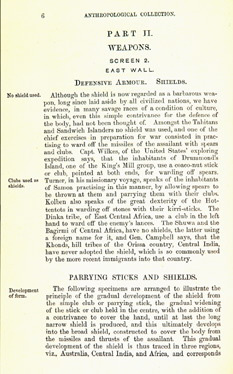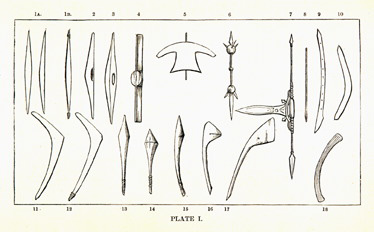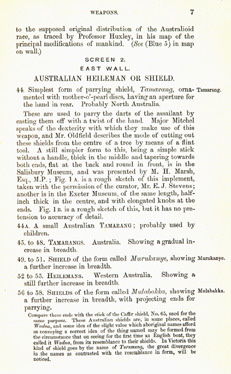Catalogue of the Displays at Bethnal Green Museum of Pitt Rivers' Collections
Australian Heileman or shields
Parrying sticks and shields, Africa

Photograph of Shield page 6 of the 1874 Catalogue.
| Development of form.
|
The following specimens are arranged to illustrate the principle of the gradual development of the shield from the simple club or parrying stick, the gradual widening of the stick or club held in the centre, with the addition of a contrivance to cover the hand, until at last the long narrow shield is produced, and this ultimately develops into the broad shield, constructed to cover the body from the missiles and thrusts of the assailant. This gradual development of the shield is thus traced in three regions, viz., Australia, Central India, and Africa, and corresponds to the supposed original distribution of the Australioid race, as traced by Professor Huxley, in his map of the principal modifications of mankind. (See (Blue 5) in map on wall.) [The latter is an instruction for Bethnal Green visitors using the catalogue as the guide to a tour of the Museum; this map is no longer available, although it may well have transferred to the Pitt Rivers Museum in Oxford in 1884]. |

Shield Plate I of 1874 Catalogue.

Photograph of Shield page 7 of the 1874 Catalogue.
44. Simplest form of parrying shield, Tamarang, ornamented with mother-of-pearl discs, having an aperture for the hand in rear. Probably North Australia. (The number 44 gives the number assigned by Pitt Rivers in his catalogue. Numbers 1 - 43 were used for physical anthropological specimens talked about in Part I of the catalogue). [1884.30.3]
These are used to parry the darts of the assailant by casting them off with a twist of the hand. Major Mitchel speaks of the dexterity with which they make use of this weapon, and Mr. Oldfield describes the mode of cutting out these shields from the centre of a tree by means of a flint tool. A still simpler form to this, being a simple stick without a handle, thick in the middle and tapering towards both ends, flat at the back and round in front, is in the Salisbury Museum, and was presented by M. H. Marsh, Esq., M.P.; Fig. 1A [see Plate 1 of the Catalogue, above] is a rough sketch of this implement, taken with the permission of the curator, Mr. E. J. Stevens; another is in the Exeter Museum, of the same length, half-inch thick in the centre, and with elongated knobs at the ends. Fig. 1B [see Plate 1 of the Catalogue, above] is a rough sketch of this, but it has no pretension to accuracy of detail.44a. A small Australian TAMARANG; probably used by children. [1884.100.53]
45 to 48. TAMARANGS. Australia. Showing a gradual increase in breadth. [45 - 1884.30.4; 46 - 1884.30.5; 47 - 1884.30.6; 48 - 1884.30.7]
49 to 51. SHIELD of the form called Murukanye, showing a further increase in breadth. [49 - 1884.30.8; 50 - 1884.30.9; 51 - 1884.30.10]
52 to 55. HEILEMANS. Western Australia. Showing a still further increase in breadth. [52 - 1884.30.11; 53 - 1884.30.12; 54 - 1884.63.1; 55 - 1884.30.13]
56 to 58. SHIELDS of the form called Mulabakka, showing a further increase in breadth, with projecting ends for parrying.
Compare these ends with the stick of the Caffir shield, No. 65, used for the same purpose. These Australian shields are, in some places, called Wadna, and some idea of the slight value which aboriginal names afford as conveying a correct idea of the thing named may be formed from the circumstance that on seeing for the first time an English boat, they called iWadna, from its resemblance to their shields. In Victoria this kind of shield goes by the name of Turnmung, the great divergence in the names as contrasted with the resemblance in form, will be noticed. [56 - 1884.30.14; 57 - 1884.30.16; 58 - 1884.30.17]
Photograph of Shield page 8 of the 1874 Catalogue.
59. MULABAKKA, made of the bark of a tree, showing a further increase in breadth, without projecting ends. [1884.30.18]
60. Oblong Australian SHIELD, made of tree bark. [1884.30.20]
Parrying sticks and shields, Africa.
61. Bow-shaped, parrying shield, DINKA, East Central Africa. It is held in the centre and the darts of the assailants parried with the hooked ends. [1884.30.21]
62. Facsimile of PARRYING SHIELD from East Africa, in the United Service Museum. Probably Kaffir. Copied by permission. [1884.30.22]
63. Facsimile of the SHIELD used by the Mundo negroes and the negroes of Ouady, Central Africa; at the back is a groove for the shaft of the spear, which is grasped by the hand whilst holding the shield. Fig. 2. [1884.30.23]
Compare this with the form of the Australian Tamarang, No. 47. Fig. 3.64. Facsimile of a wooden PARRYING SHIELD found in an ancient Egyptian tomb, in the Museum of the Louvre at Paris, from accurate measurements taken by Col. Fox. Fig. 4. Copied by permission of the authorities. [1884.30.24]
65. KAFFIR SHIELD of hide, with parrying stick at back. East Africa. [1884.30.35]
Compare this form with that of No. 56 from Australia. In each case the projection at the end serves to catch the darts of the assailant and turn them aside by a twist of the hand. A similar stick also projecting beyond the ends is used at the back of the leather shield of the negroes of Soudan, and Speke represents a similar projection at the ends of the long narrow shields of the Kidi men on a visit to King Kamrasi (page 567 of his work). A shield of similar form of crocodile's skin with a projecting stick from the White Nile is in the Christy Collection, and another of giraffe's skin, shaped like an inverted Norman arch, but with a similar stick from Kordofan is in the same collection. On the sides of the Kaffir shield there is sometimes a slight indentation, the object of which is doubtful, and is probably retained through fashion; it extends throughout many parts of Africa and is of different sizes. A similar notch is seen in the Nubian shield, No. 95.66. OBLONG SHIELD of Elephant's hide. Fan negroes, Gaboon, West Africa. [1884.30.34]
67. SHIELD of Elephant's hide, with wings on the upper end. Fan negroes, Gaboon, West Africa.
The wings of this shield resemble those of the cowhide shields of the Bassutos of South-east Africa (Fig. 5), the two forms are sufficiently close to denote connexion. It is not known whether this form of shield prevails in the district intermediate between the Gaboon and the country of the Bassutos. This form of shield must have somewhat resembled the Greek pelte [NB this word has been transliterated from the Greek text that it is in the 1874 catalogue. Oxford English Dictionary has it as 'pelta', (plural = peltae) 'a small light shield used by the ancient Greeks, Romans, etc.' (Greek = pelte), described by Zenophon as being of the form of an ivy leaf, and which was borrowed from the Amazons. [1884.30.32]
Photograph of Shield page 9 of the 1874 Catalogue.
68. OVAL WICKER SHIELD of the Neam Nam negroes. Central Africa.
"Made of reeds or the leaf of the palm tree, interwoven in patterns of black and white. It is held by the handle in rear of the centre when giving battle, the Neam Nam has two or three of the iron boomerangs (Nos. 183 to 185), suspended by a leather button to the inside of the shield lying directly over the handle of it; the whole of which and a couple of lances he grasps in the left hand, whilst with a lance in the right hand he assails the enemy. The shield, made of so light a substance, will not repel a lance, but when struck by one, the combatant giving a slight movement either to the right or left, counteracts the penetration of the lance, which becoming entangled and suspended in the shield, furnishes him with his enemy's weapon in lieu of his own, which he is supposed to have cast." Obtained by Consul Petherick. See Royal United Service Journal, vol. iv. p. 176. [1884.30.33]
Parrying shields of double antelopes' horns, India.
69. PARRYING SHIELD of double antelopes' horns called Madu or Maru. India. These are held in the centre and used for parrying by turning off the darts of the assailant in the same manner as the parrying shields of Australia and Africa.
This weapon is generally carried by the Fakirs, Jogis and other religious mendicants, Mussulman and Hindu. It is also found amongst the Bhils. For information respecting this weapon the writer is indebted to Sir Walter Elliot, K.C.S.I. This weapon is here in its simplest form. [1884.30.25]70. PARRYING SHIELD, similar to No. 69, with the addition of iron points which enable the weapon to be used for thrusting as well. [1884.30.26]
71. PARRYING SHIELD, similar to Nos. 69 and 70 with the addition of a small shield or hand guard. Another variety of this weapon has a straight broad blade springing from the handle in the centre at right angles to the parrying horns. The whole weapon is sometimes made of steel. [1884.30.27]
72. POINTED INSTRUMENT of antelope's horn. India. Probably a dervish's or fakir's crutch. [1884.58.56]
In Meyrick's Ancient Armour, vol. ii. pl. cxlvi. figs. 8 and 9, there is an illustration of a Japanese weapon evidently used in the same manner for parrying (Fig. 6), and in Boutell's Arms and Armour, fig. 61, page 269, there is an engraving of a parrying weapon, with a blade at right angles to the handle, described as a Moorish adarque, 15th century, which, if correct, proves by its form its oriental origin. Fig. 7.
Photograph of Shield page 10 of the 1874 Catalogue.
Long narrow shields from the Asiatic Isles.
The use of the long, narrow shield extends over the greater part of the Asiatic isles lying between Australia and the continent of Asia, and is used in a similar manner to those already described. There are innumerable varieties, showing various degrees of expansion, many of which may be seen in the Christy Collection, in Victoria Street. All show traces of development from a parrying stick similar to that of the Australians.
73. PARRYING SHIELD, Molucca Islands, with mother-of-pearl studs, held by the hand in rear, like the preceding examples. [1884.30.28]
74. PARRYING SHIELD, inlaid with shells. Molucca Islands. [1884.30.29]
75. PARRYING SHIELD, inlaid with shells. Molucca Islands. [1884.30.30]
76. PARRYING SHIELD, somewhat longer than the preceding specimens, Molucca Islands, covered with sheet brass, in which the shell studs of the previous specimens are imitated in relief. [1884.30.31]
77. SHIELD of the Dyaks of Borneo, called "Utap," ornamented with a human figure, painted. [1884.30.36]
78. SHIELD of the Dyaks of Borneo, called "Utap," ornamented with human hair. [1884.30.37]
79. Narrow WICKER SHIELD, of Ysabel Island, one end being somewhat larger than the other.
The use of wicker work for shields was common in many countries, being a light and suitable material for the purpose. The Assyrians are represented using a small oblong shield, and also a larger one, apparently of wicker work. The shields used by the Homeric heroes were sometimes of osiers, twisted together, covered with ox-hides, and called itea; [modern Greek itia, a type of tree] or of wood. (Smith, Dict. of Greek and Roman Antiquities.) The Musgu of Central Africa carry a wicker shield. The negroes of the Gold Coast, according to Bosman, carried a wicker shield. The Marghi are spoken of by Barth as carrying a large shield of reeds, called Chaggo by the Marghi, and Kutufani by the Kanuri, big enough for the protection of two or three persons. The Tartars, at the attack of Kief, in 1239, carried bucklers of twisted willow branches. The Chinese and the Turks used wicker shields. One of the chief advantages of this material is, that the lance of the enemy, especially if barbed, by piercing the shield, becomes entangled in the wicker work and is thus rendered useless to its owner. [1884.140.8]79a. WICKER SHIELD, Ysabel Island, of the same form as No. 79, but with a slight concavity at the sides. [1884.140.9]